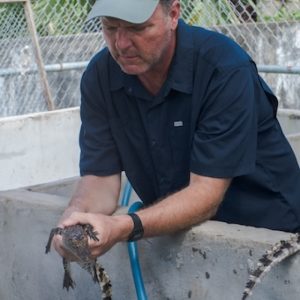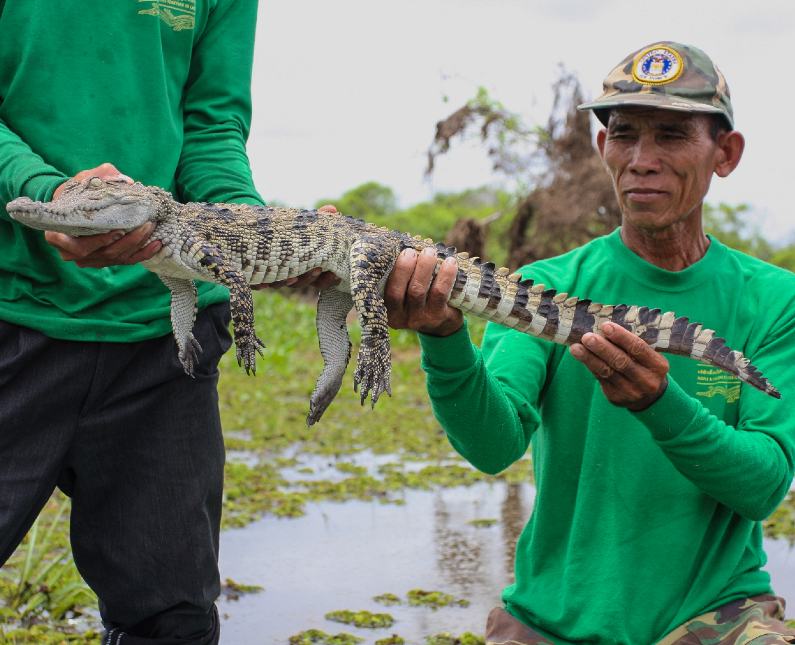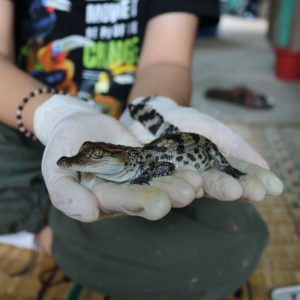During 2024, Dolphin Energy partnered with the Mohamed bin Zayed Species Conservation Fund to enhance the Chairman’s Award within our Small Grants Programme, focusing on supporting endangered flora and fauna.
The projects chosen by our Advisory Board are selected based on their impact, scalability, contributions to species programs, and career development opportunities. We place a strong emphasis on essential conservation skills, such as community engagement and stakeholder collaboration.
Thanks to Dolphin Energy, the MBZ Fund were able to aid the Bermuda Petrel through The Nonsuch Expeditions, the Lebanon Iris via the Biodiversity Conservation Initiative, and Axolotl (Mexico) in partnership with Dr Felipe Osuna. The latest grant involves the conservation of the Siamese crocodile in Laos. We recently caught up with Robert van Zalinge to hear more about this unique Dolphin Energy supported project.
Editor: What is your name and surname, and what role do you play in this project?
 Robert van Zalinge: My name is Robert van Zalinge and I’m the Technical Advisor in the Xe Champhone – Xe Xangxoy floodplains in Savannakhet province, Southern Laos.
Robert van Zalinge: My name is Robert van Zalinge and I’m the Technical Advisor in the Xe Champhone – Xe Xangxoy floodplains in Savannakhet province, Southern Laos.
ED: What ignited your passion for conservation?
RvZ: I grew up in the tropics and lived in some beautiful landscapes with amazing wildlife, most notably the Himalayas and Great Rift Valley in Eastern Africa. As a young adult, I became enthralled by the combined wonders of Southeast Asia, and it is here that I fully became a conservationist.
ED: Oh wow, that sounds idyllic, must have been an incredible childhood
RvZ: Indeed, filled with lots of nature moments
ED: Can you explain who WCS is and where it all started?
RvZ: I first encountered the Wildlife Conservation Society (WCS) as a young student in the rainforests of the Central African Republic. There I met a conservation scientist doing long-term research on African Forest Elephants, for WCS. She told me what WCS had been doing, and I was deeply impressed.
WCS was established in 1895 and works all over the world. We are committed to conserving wildlife in wild places for the long term and are very strong in building up a new generation of conservationists wherever we work. WCS began working in Lao PDR in the 1980s, surveying wildlife and habitats around the country to assist the government to create Lao PDR’s national protected area system. In the early 1990s, WCS documented wildlife and habitats in many of the newly created national protected areas and began supporting the government to train protected area managers, as well as raise awareness about illegal wildlife trade. WCS established a country office in Lao PDR in 1994. Our vision at the Lao PDR Program is that the unique ecosystems of Lao PDR thrive indefinitely and are valued by the people of Lao PDR, and the world, for their biodiversity, natural beauty, and the services they provide to humanity. A core theme is the protection and improved management of biodiversity values by building the capacity of government and local stakeholders, improving management of wildlife and wild places through community engagement, and combatting illegal wildlife trade.
ED: How does WCS collaborate with the MBZ Fund on this project?
RvZ: We are receiving funding support from the MBZ Fund and Dolphin Energy to work with local communities on protecting wetlands and to work on conservation management of the Siamese Crocodile (Crocodylus siamensis) population.
ED: What led WCS to choose the Xe Champhone – Xe Xangxoy floodplains in Laos as the focus area for this project?
RvZ: The Xe Champhone Wetland is the largest of Lao PDR’s two Ramsar sites and contains core habitat for one of the largest breeding populations of Siamese Crocodiles in the wild, anywhere in the world. WCS had identified this population as vital to the conservation of the Siamese Crocodile already in 2010. At that time, without the threat of land conversion as we are seeing these days, it was felt it was enough to work on boosting the population through a head-starting program, implemented together with local communities.
Unfortunately, funding support was constrained which limited conservation activities between 2014 – 2019. When WCS fully reengaged in 2019, large-scale conversion of wetlands to cultivate dry-season rice had become a major existential threat to Siamese Crocodiles in the Xe Champhone – Xe Xangxoy floodplain, thereby for their continued persistence in Laos and ultimately, the global outlook for this species to survive in the wild.
ED: That’s fascinating, what sets this project apart from others in the field?
RvZ: The project leans on a very strong collaboration with local communities. They have essentially become part of the conservation team. They monitor for new threats to the wetlands, inform people who already farm in the area about the regulations that apply and how to minimize their impact to critical nesting areas, they conduct nest searches, incubate the eggs and raise the young crocodiles until they are large enough to survive in the wild.
ED: Community awareness is very important, whether through outreach or engagement, we need support, from donors like Dolphin Energy or people co-existing with the species on a daily basis.
ED: Is there an interesting aspect of the project or species that isn’t widely known?
RvZ: There have been no known attacks in the wild on people by Siamese Crocodiles in our project area and it is believed this species will not actively hunt people given the opportunity, instead seeking avoidance as much as possible. People can regularly be seen wading through the wetland.
ED: Oh wow, that’s reassuring to know. Why do you believe this project deserves recognition with an MBZ Fund/Dolphin Energy Chairman’s Award?
RvZ: We have just entered another period of low fund availability, yet we are at a critical point, with immense pressure from land conversion and without the area having yet received the protected area status it needs. This MBZ Fund Chairmans Award, supported from Dolphin Energy came at a very crucial period in the project.
ED: What role does this species play in its ecosystem?
RvZ: Apex predators such as the Siamese Crocodile keep natural ecosystems healthy. By controlling populations of prey species, they reduce impact on plants and other animals. In other words, they help keep the ecosystem in balance. They can also reduce the risk of serious disease outbreaks by rapidly removing sick animals from the population.
ED: What specific conservation outcomes do you aim to achieve through this project?
RvZ: We aim to have protected the remaining wetlands and the nesting areas we know of during the upcoming year, while we simultaneously work to ensure the wetlands are protected under the law.
ED: How does the local community depend on or interact with this species?
RvZ: Local residents are largely pro crocodile conservation through their own animistic belief in crocodiles as guardians to the spirit world. In a village outside our project area, a single wild female crocodile lives in wetlands around the village. People feed it and it has even come to the village begging for food. This is an extreme and not something we encourage, but it shows how benevolent people can be to crocodiles in this area.
ED: What do you enjoy most about working with this species?
RvZ: Seeing the young crocodiles in our head-starting facility. They are very cute but vulnerable at that age. We keep them until they are around a meter long and then release them back into the wetland. In this way we have given them a “headstart”, avoiding the many risks of being a very small young crocodile in a large wetland filled with threats.
ED: This project is so inspiring. Thank you for your time, that was incredibly insightful. Good luck with the project and we’ll track the success.
RvZ: It’s my pleasure and thank you for the support MBZ Fund and Dolphin Energy.



